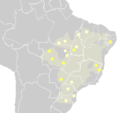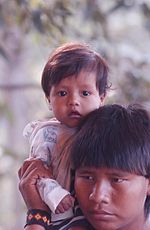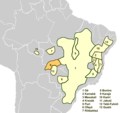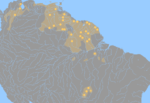The Jê languages (also spelled Gê, Jean, Ye, Gean), or Jê–Kaingang languages, are spoken by the Jê, a group of indigenous peoples in Brazil. The Jê family...
28 KB (535 words) - 20:41, 28 August 2023
centered on the Jê language family, with most other branches currently being single languages due to recent extinctions. The Macro-Jê family was first...
19 KB (1,604 words) - 17:36, 5 January 2024
among Jê, Tupian, Cariban, Arawakan, and Trumai languages is also evident among the languages of the Xingu Indigenous Park. Comparison of Proto-Macro-Jê (with...
18 KB (981 words) - 04:35, 18 April 2024
Paraná Jê languages, also known as Jê of Paraná, are a branch of the Jê languages constituted by the extinct language Ingain and by the Southern Jê languages...
1 KB (54 words) - 23:02, 14 June 2023
The Northern Jê: 6 or Core Jê languages (Portuguese: Jê Setentrionais) are a branch of the Jê languages constituted by the Timbira dialect continuum...
45 KB (3,174 words) - 03:55, 6 January 2024
Cerrado languages (also referred to as Amazonian Jê: 549 ) are a branch of the Jê languages constituted by the Goyaz Jê languages and Akuwẽ (Central Jê).: 14–5 ...
8 KB (410 words) - 18:06, 5 June 2024
usually considered part of the Macro-Jê language family. Maxakalían languages were first classified into the Jê languages. It was only in 1931 that Čestmír...
13 KB (1,230 words) - 08:16, 26 October 2024
Jê or Gê are the people who spoke Jê languages of the northern South American Caribbean coast and Brazil. In Brazil, the Jê were found in Rio de Janeiro...
2 KB (99 words) - 13:29, 4 October 2024
The Akuwẽ: 12–4 or Central Jê: 547 languages are a branch of the Jê languages constituted by two extant languages (Xavánte and Akwẽ-Xerénte) and two...
9 KB (603 words) - 16:28, 30 July 2023
The Southern Jê languages are a branch of the Jê languages constituted by the Kaingang and Laklãnõ (Xokléng) languages.: 14–5 Together with the closely...
1 KB (57 words) - 17:13, 5 September 2021
classified as a Northern Jê language in earlier scholarship,: 547 Panará differs considerably from the Northern Jê languages in its morphosyntax: 454 ...
22 KB (1,878 words) - 11:02, 5 January 2024
The Goyaz Jê languages (also Northern Jê–Panará: 95 ) are a branch of the Jê languages constituted by the Northern Jê languages and Panará (and its predecessor...
7 KB (553 words) - 19:57, 7 August 2023
The Kaingang language (also spelled Kaingáng) is a Southern Jê language (Jê, Macro-Jê) spoken by the Kaingang people of southern Brazil. The Kaingang nation...
17 KB (1,392 words) - 02:35, 30 July 2024
Botocudoan or Borum languages, now sometimes known as Krenakan after the last one remaining, are a branch of the Macro-Jê languages – spoken mainly in...
10 KB (841 words) - 20:42, 28 August 2023
The Trans-Tocantins languages are a proposed subgroup of the Northern Jê languages, which comprises four languages spoken to the west of the Tocantins...
3 KB (202 words) - 19:15, 3 October 2023
The Trans-Araguaia languages are a proposed subgroup of the Northern Jê languages, which comprises three languages spoken to the west of the Araguaia...
2 KB (84 words) - 17:12, 5 September 2021
Timbira is a dialect continuum of the Northern Jê language group of the Jê languages ̣(Macro-Jê) spoken in Brazil. The various dialects are distinct enough...
6 KB (522 words) - 20:40, 28 August 2023
Xokleng or Laklãnõ is a Southern Jê language (Jê, Macro-Jê) spoken by the Xokleng people of Brazil. It is closely related to Kaingang. Alternate names...
4 KB (233 words) - 02:00, 9 August 2024
related to the Jê languages. Mason (1950) lists: Kariri Cariri Kipea Camurú Dzubucua Pedra Branca Sapuya Below is a full list of Kiriri languages and dialects...
20 KB (1,147 words) - 16:38, 23 June 2024
2010. "Nimuendajú was right: The inclusion of the Jabutí language family in the Macro-Jê stock." International Journal of American Linguistics, 76(4)...
11 KB (203 words) - 05:01, 10 July 2024
The Kamakã languages are a small family of extinct Macro-Jê languages of Bahía, northeastern Brazil. The attested Kamakã languages are: (northern) Kamakã...
9 KB (463 words) - 16:05, 17 July 2021
Northern Jê language (Jê, Macro-Jê) spoken in Mato Grosso, Brazil. It is closely related to Tapayúna; together, they form the Tapajós branch of Northern Jê.: 7 ...
18 KB (1,423 words) - 13:24, 1 February 2024
(Mẽbêngôkre: Mẽbêngôkre kabẽn [mẽbeŋoˈkɾɛ kaˈbɛ̃n]) is a Northern Jê language (Jê, Macro-Jê) spoken by the Kayapó and the Xikrin people in the north of Mato...
41 KB (3,265 words) - 00:39, 12 May 2024
Borôroan languages of Brazil are Borôro and the extinct Umotína and Otuke. They are sometimes considered to form part of the proposed Macro-Jê language family...
12 KB (966 words) - 06:26, 29 April 2024
Tapajós: 7 (also called Suyá and Trans-Xingu: 535 ) languages are a close-knit group of the Northern Jê languages, which comprises Kĩsêdjê and Tapayúna (Kajkwakhrattxi)...
7 KB (369 words) - 14:58, 8 March 2023
The Xavante language is an Akuwẽ (Central Jê) language (Jê, Macro-Jê) spoken by the Xavante people in the area surrounding Eastern Mato Grosso, Brazil...
36 KB (4,790 words) - 20:58, 30 September 2024
Tupi language families due to contact. Extensive lexical similarities between Cariban and various Macro-Jê languages suggest that Cariban languages had...
74 KB (1,733 words) - 15:36, 9 July 2024
JE) Je (Cyrillic), a character in several alphabets Jê languages, a language family of Brazil Yei language, or Je, a language of Papua New Guinea Je,...
2 KB (237 words) - 10:13, 9 October 2024
possible language isolate spoken by 1% of the Guató people of Brazil. Kaufman (1990) provisionally classified Guató as a branch of the Macro-Jê languages, but...
8 KB (482 words) - 23:14, 17 October 2024
Nominative–absolutive alignment (redirect from Nominative-absolutive language)
clauses of the Tuparian languages (Makurap, Wayoró, Tuparí, Sakurabiat, and Akuntsú).: 191 : 99 In the Northern Jê language Canela, different main clause...
9 KB (1,062 words) - 10:08, 18 August 2024












